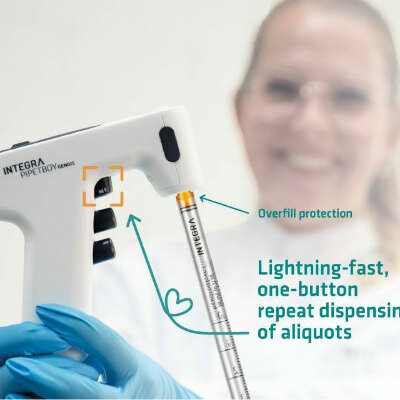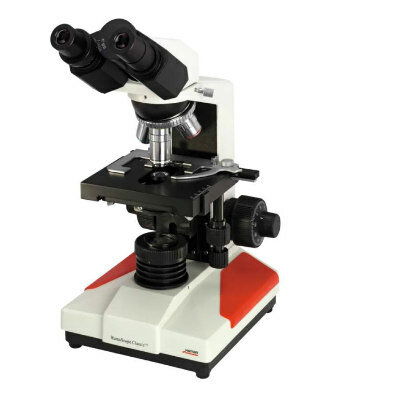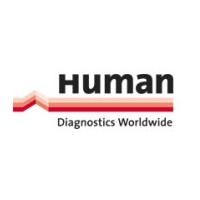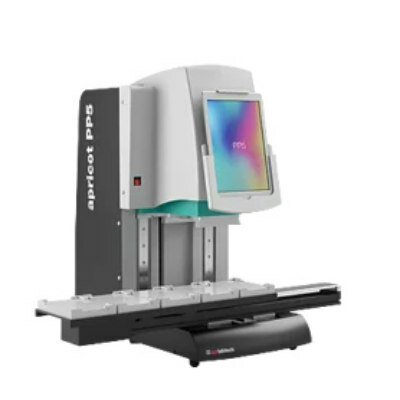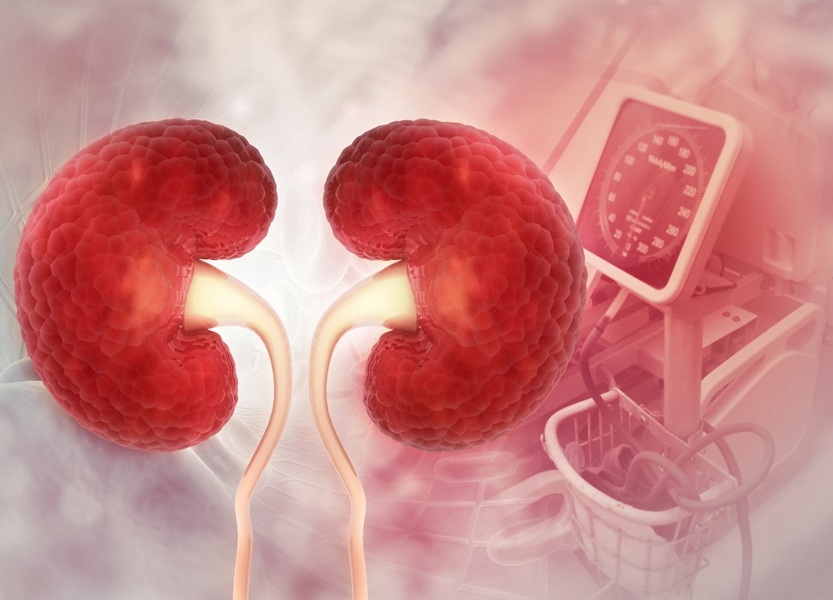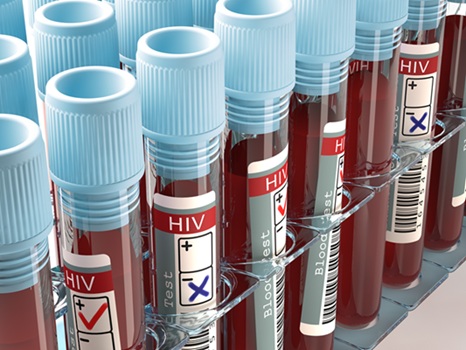Novel Technique Captures Plasma Cells from Myeloma Patients
|
By LabMedica International staff writers Posted on 27 Apr 2017 |
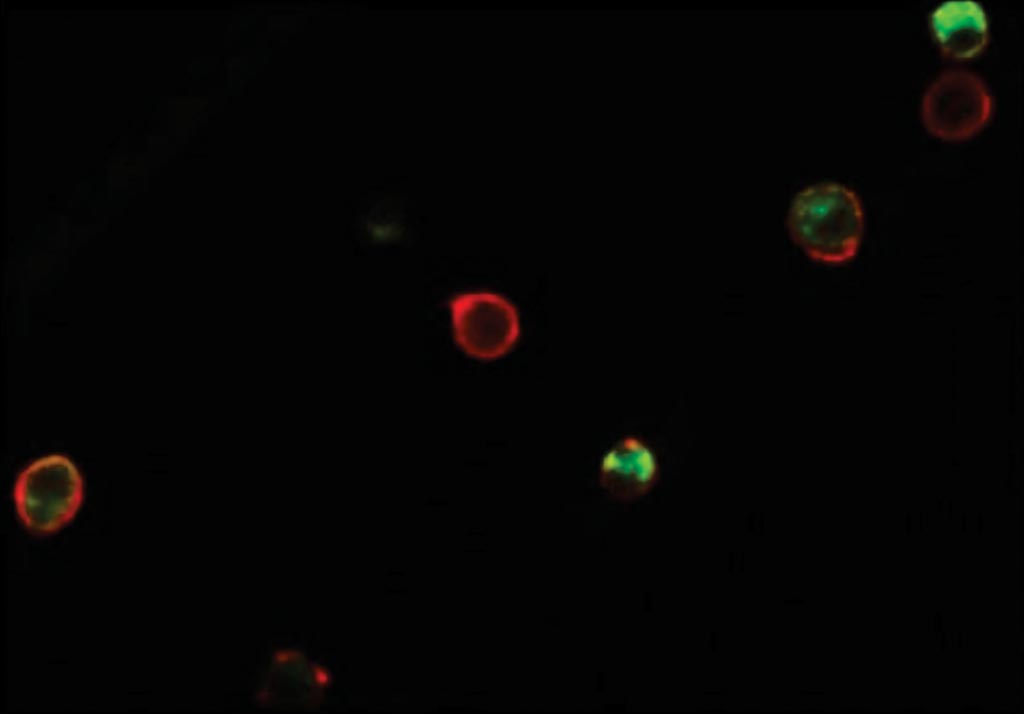
Image: Fluorescence micrograph of captured plasma cells from a clinical sample. Red fluorescence denotes CD138, while green denotes κ light chain antibody (Photo courtesy of Massachusetts Institute of Technology).
Multiple myeloma is a cancer of the plasma cells, which are white blood cells produced in bone marrow that churn out antibodies to help fight infection. When plasma cells become cancerous, they produce abnormal proteins, and the cells can build up in bone marrow, ultimately seeping into the bloodstream.
The disease is typically diagnosed through a bone marrow biopsy, in which a needle is inserted near a patient's hipbone to suck out a sample of bone marrow, which is a painful process for many patients. Clinicians can then isolate and analyze the plasma cells in the bone marrow sample to determine if they are cancerous.
Bioengineers at the Massachusetts Institute of Technology and their colleagues collected both peripheral blood and bone marrow (BM) in EDTA tubes from newly diagnosed myeloma patients. For studies with clinical blood samples from patients, capture, washing, and CD138 antibody labelling were performed. For studies involving BM, samples were passed through 100-μm nylon cell strainer to remove debris before being introduced to the capture chip. After the capture experiment, the same washing and labelling steps were followed.
The team used a microfluidic herringbone design to capture circulating plasma cells. They coated the channels of a microchip, about the size of a glass slide, with CD138, an antibody that is also expressed on the membranes of plasma cells. The team then streamed 1 mL samples of blood through the device. The herringbone grooves circulated the blood in the microfluidic channels, where the antibodies, acting as tiny Velcro pads, grabbed onto any passing plasma cells while letting the rest of the blood flow out of the device.
After counting the number of cells captured in each sample, they observed very low numbers of circulating plasma cells in healthy samples, about two to five cells/mL of blood, versus substantially higher counts in patients diagnosed with multiple myeloma, of about 45 to 184 cells/mL. The team also analyzed the captured plasma cells to determine the type of antibodies they produced. The scientists noted that patients who were in remission exhibited higher counts of circulating plasma cells than healthy donors. These same patients had shown normal ratios of kappa- and lambda-type antibodies in conventional blood tests.
Rohit Karnik, PhD, an associate professor and co-author of the study said, “We can capture and stain these cells in the device, which opens the possibility of studying whether there are new mutations in the cells. With cancers like multiple myeloma, even for patients in remission, cancer can recur. Detecting the level or mutation of plasma cells in blood might provide an early detection method for these patients.” The study was published on April 4, 2017, in the journal Scientific Reports.
The disease is typically diagnosed through a bone marrow biopsy, in which a needle is inserted near a patient's hipbone to suck out a sample of bone marrow, which is a painful process for many patients. Clinicians can then isolate and analyze the plasma cells in the bone marrow sample to determine if they are cancerous.
Bioengineers at the Massachusetts Institute of Technology and their colleagues collected both peripheral blood and bone marrow (BM) in EDTA tubes from newly diagnosed myeloma patients. For studies with clinical blood samples from patients, capture, washing, and CD138 antibody labelling were performed. For studies involving BM, samples were passed through 100-μm nylon cell strainer to remove debris before being introduced to the capture chip. After the capture experiment, the same washing and labelling steps were followed.
The team used a microfluidic herringbone design to capture circulating plasma cells. They coated the channels of a microchip, about the size of a glass slide, with CD138, an antibody that is also expressed on the membranes of plasma cells. The team then streamed 1 mL samples of blood through the device. The herringbone grooves circulated the blood in the microfluidic channels, where the antibodies, acting as tiny Velcro pads, grabbed onto any passing plasma cells while letting the rest of the blood flow out of the device.
After counting the number of cells captured in each sample, they observed very low numbers of circulating plasma cells in healthy samples, about two to five cells/mL of blood, versus substantially higher counts in patients diagnosed with multiple myeloma, of about 45 to 184 cells/mL. The team also analyzed the captured plasma cells to determine the type of antibodies they produced. The scientists noted that patients who were in remission exhibited higher counts of circulating plasma cells than healthy donors. These same patients had shown normal ratios of kappa- and lambda-type antibodies in conventional blood tests.
Rohit Karnik, PhD, an associate professor and co-author of the study said, “We can capture and stain these cells in the device, which opens the possibility of studying whether there are new mutations in the cells. With cancers like multiple myeloma, even for patients in remission, cancer can recur. Detecting the level or mutation of plasma cells in blood might provide an early detection method for these patients.” The study was published on April 4, 2017, in the journal Scientific Reports.
Latest Pathology News
- Advanced Imaging Reveals Mechanisms Causing Autoimmune Disease
- AI Model Effectively Predicts Patient Outcomes in Common Lung Cancer Type
- AI Model Predicts Patient Response to Bladder Cancer Treatment
- New Laser-Based Method to Accelerate Cancer Diagnosis
- New AI Model Predicts Gene Variants’ Effects on Specific Diseases
- Powerful AI Tool Diagnoses Coeliac Disease from Biopsy Images with Over 97% Accuracy
- Pre-Analytical Conditions Influence Cell-Free MicroRNA Stability in Blood Plasma Samples
- 3D Cell Culture System Could Revolutionize Cancer Diagnostics
- Painless Technique Measures Glucose Concentrations in Solution and Tissue Via Sound Waves
- Skin-Based Test to Improve Diagnosis of Rare, Debilitating Neurodegenerative Disease
- Serum Uromodulin Could Indicate Acute Kidney Injury in COVID-19 Patients
- AI Model Reveals True Biological Age From Five Drops of Blood
- First-Of-Its-Kind AI Tool Visualizes Cell’s ‘Social Network’ To Treat Cancer
- New Test Diagnoses High-Risk Childhood Brain Tumors
- Informatics Solution Elevates Laboratory Efficiency and Patient Care
- Microfluidic Device Assesses Stickiness of Tumor Cells to Predict Cancer Spread
Channels
Clinical Chemistry
view channel
Carbon Nanotubes Help Build Highly Accurate Sensors for Continuous Health Monitoring
Current sensors can measure various health indicators, such as blood glucose levels, in the body. However, there is a need to develop more accurate and sensitive sensor materials that can detect lower... Read more
Paper-Based Device Boosts HIV Test Accuracy from Dried Blood Samples
In regions where access to clinics for routine blood tests presents financial and logistical obstacles, HIV patients are increasingly able to collect and send a drop of blood using paper-based devices... Read moreMolecular Diagnostics
view channel
RNA-Based Blood Test Detects Preeclampsia Risk Months Before Symptoms
Preeclampsia remains a major cause of maternal morbidity and mortality, as well as preterm births. Despite current guidelines that aim to identify pregnant women at increased risk of preeclampsia using... Read more
First Of Its Kind Test Uses microRNAs to Predict Toxicity from Cancer Therapy
Many men with early-stage prostate cancer receive stereotactic body radiotherapy (SBRT), a highly precise form of radiation treatment that is completed in just five sessions. Compared to traditional radiation,... Read moreNovel Cell-Based Assay Provides Sensitive and Specific Autoantibody Detection in Demyelination
Anti-myelin-associated glycoprotein (MAG) antibodies serve as markers for an autoimmune demyelinating disorder that affects the peripheral nervous system, leading to sensory impairment. Anti-MAG-IgM antibodies... Read moreHematology
view channel
New Scoring System Predicts Risk of Developing Cancer from Common Blood Disorder
Clonal cytopenia of undetermined significance (CCUS) is a blood disorder commonly found in older adults, characterized by mutations in blood cells and a low blood count, but without any obvious cause or... Read more
Non-Invasive Prenatal Test for Fetal RhD Status Demonstrates 100% Accuracy
In the United States, approximately 15% of pregnant individuals are RhD-negative. However, in about 40% of these cases, the fetus is also RhD-negative, making the administration of RhoGAM unnecessary.... Read moreImmunology
view channel
Stem Cell Test Predicts Treatment Outcome for Patients with Platinum-Resistant Ovarian Cancer
Epithelial ovarian cancer frequently responds to chemotherapy initially, but eventually, the tumor develops resistance to the therapy, leading to regrowth. This resistance is partially due to the activation... Read more
Machine Learning-Enabled Blood Test Predicts Immunotherapy Response in Lymphoma Patients
Chimeric antigen receptor (CAR) T-cell therapy has emerged as one of the most promising recent developments in the treatment of blood cancers. However, over half of non-Hodgkin lymphoma (NHL) patients... Read moreMicrobiology
view channel
Handheld Device Deliver Low-Cost TB Results in Less Than One Hour
Tuberculosis (TB) remains the deadliest infectious disease globally, affecting an estimated 10 million people annually. In 2021, about 4.2 million TB cases went undiagnosed or unreported, mainly due to... Read more
New AI-Based Method Improves Diagnosis of Drug-Resistant Infections
Drug-resistant infections, particularly those caused by deadly bacteria like tuberculosis and staphylococcus, are rapidly emerging as a global health emergency. These infections are more difficult to treat,... Read more
Breakthrough Diagnostic Technology Identifies Bacterial Infections with Almost 100% Accuracy within Three Hours
Rapid and precise identification of pathogenic microbes in patient samples is essential for the effective treatment of acute infectious diseases, such as sepsis. The fluorescence in situ hybridization... Read moreTechnology
view channel
Pain-On-A-Chip Microfluidic Device Determines Types of Chronic Pain from Blood Samples
Chronic pain is a widespread condition that remains difficult to manage, and existing clinical methods for its treatment rely largely on self-reporting, which can be subjective and especially problematic... Read more
Innovative, Label-Free Ratiometric Fluorosensor Enables More Sensitive Viral RNA Detection
Viruses present a major global health risk, as demonstrated by recent pandemics, making early detection and identification essential for preventing new outbreaks. While traditional detection methods are... Read moreIndustry
view channel
Cepheid and Oxford Nanopore Technologies Partner on Advancing Automated Sequencing-Based Solutions
Cepheid (Sunnyvale, CA, USA), a leading molecular diagnostics company, and Oxford Nanopore Technologies (Oxford, UK), the company behind a new generation of sequencing-based molecular analysis technologies,... Read more
Grifols and Tecan’s IBL Collaborate on Advanced Biomarker Panels
Grifols (Barcelona, Spain), one of the world’s leading producers of plasma-derived medicines and innovative diagnostic solutions, is expanding its offer in clinical diagnostics through a strategic partnership... Read more




